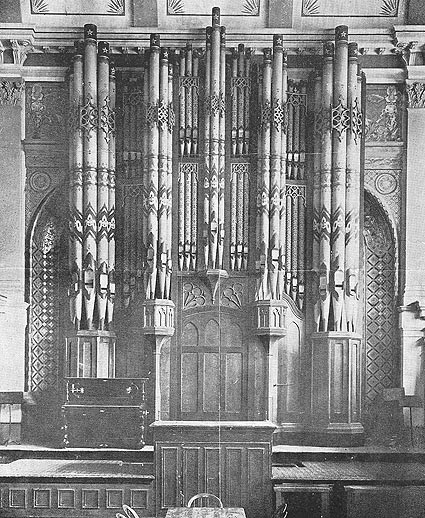Freemasons Hall
Collins Street, Melbourne
Fincham & Hobday 1888, 3 manuals, 42 speaking stops, tubular-pneumatic action

The organ was built in 1888 by Fincham & Hobday and exhibited in the Melbourne Centennial International Exhibition of that year where it was awarded a First Order of Merit. In January 1890 it was installed at Freemasons Hall, Collins Street, Melbourne.
Following extensive alterations to the Hall, the instrument was sold and installed at the Lyceum Hall, Sydney in 1905 and removed in c.1929. Parts were used for other organs built by C.W. Leggo and S.T. Noad.
From the Organ Music Society website page on Wesley Uniting Church, Sydney:
1905: An organ by George Fincham (1888) was installed from the Centennial International Exhibition, Melbourne (3 manuals, 42 speaking stops, tubular-pneumatic action) in the Lyceum Hall, Sydney. This organ had been installed in the Masonic Hall, Melbourne in 1889 and was subsequently sold in 1905 to Ebenezer Vickery MLC for installation in the Lyceum Hall which he donated to the Central Methodist Mission in 1908. This was the third largest organ built in 19th century Australia – the two that were larger were at the Exhibition Building, Melbourne (1880) and at the Australian Church, Melbourne (1890) both by the Fincham firm. It was a remarkable example of late nineteenth-century organbuilding in conservative Romantic style. While its sound is now beyond recall, the specification, with its well-developed Diapason ensemble (including the Pedal division with Principals at 8', 5-1/3' and 4' pitches) clearly reflects the classical outlook of conservative English builders like Hill & Son, who, in turn, had been influenced by the North German eighteenth-century organ. The specification of the 1888 Fincham organ was:
Lyceum Hall, Sydney (1888 Fincham organ)
| Great Double Open Diapason Open Diapason Loud Gamba Clarabella Octave Wald Flute Twelfth Fifteenth Mixture Posaune Clarion Choir & Solo (enclosed) Dulciana Gamba Voix Celeste Lieblich Gedact Flute Harmonique Clear Flute Piccolo Harmonique Bassoon Clarionet Orchestral Oboe Vox Humana Oboe Clarion |
16 8 8 8 4 4 3 2 3 ranks 8 4 8 8 8 8 8 4 2 16 8 8 8 4 |
Swell Gedact Geigen Principal Gedact Salicional Gemshorn Rohrflöte Piccolo Mixture Cornopean Oboe Clarion Pedal Sub Bass Open Diapason Bourdon Principal Bass Flute Twelfth Fifteenth Trombone 12 couplers Tremulant 13 thumb pistons Tubular pneumatic action |
16 8 8 8 4 4 2 3 ranks 8 8 4 32 16 16 8 8 6 4 16 |
1928: The Fincham organ was removed and broken up and replaced by a 9-rank Christie (Hill, Norman & Beard) organ
Click here for a pdf of the pamphlet issued by George Fincham & Son c.1900. This pamphlet contains a full specification and description of the organ.